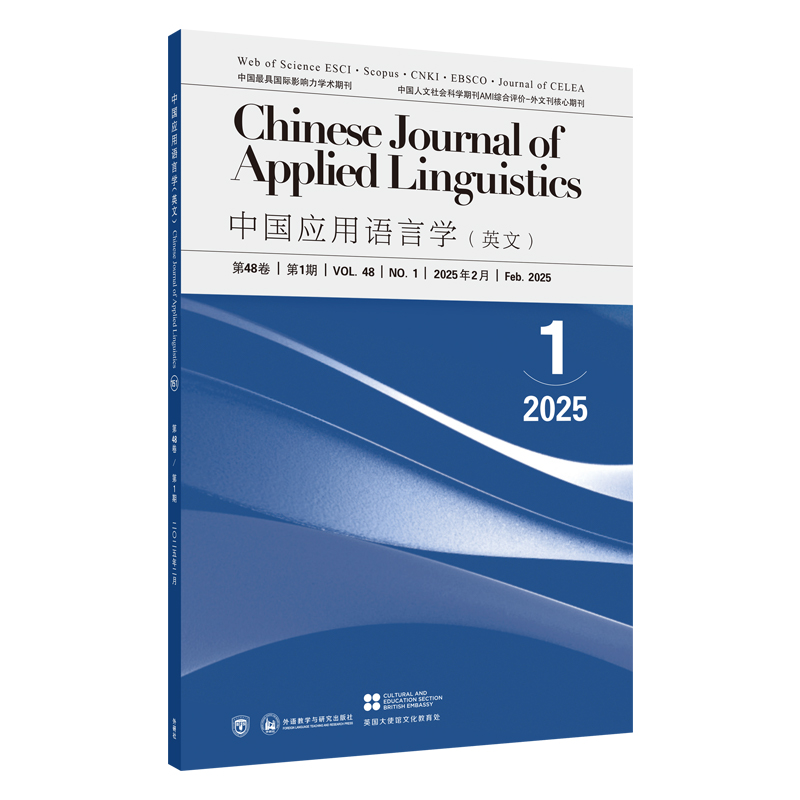投稿须知与格式
《中国应用语言学》论文格式以APA格式(第6版)为准。
一、正文格式:
1. 本刊只接受网上在线投稿,不接受纸质稿件和通过电子邮件投稿。(投稿网址:http://submit.celea.org.cn/cjal)
2. 本刊采用双盲同行专家匿名制评审制,论文正文中不要出现作者姓名和工作单位等个人信息。
3. 论文正文中要有中文提要(200-300字左右)、英文提要(150-200词左右)以及5-10个中英文关键词。
4. 文中小标题必须标序号,请用阿拉伯数字标识,不要用罗马数字标识。
5. 文中表格为不封口的三线表,即上面两条线,底边一条线。
6. 凡正文中出现的文献必须列在文后参考文献中;凡文后参考参考文献中列出的文献必须在正文中引用,正文中未引用的文献不得列在文后参考文献中。
7. 正文中无论是间接引用还是直接引用文献,都要给出文献页码。例:(Hu, 2006:15-21)。如果对文献的转述需参考该书多个章节,可不加页码。直接引用必须加双引号,间接引用和转述不加引号。
8. 转引格式如下:Peterson (as cited in Samovar & Porter, 1997: 3) states that language involves attaching meaning to …
9. 正文中用到汉字时,需注明拼音和英文释义。
10. 研究设计中的时态一般是过去时。
二、文后参考文献格式:(按照首字母顺序排列。注意大小写。)
1. 专著文献格式:
Ebel, R. & Frisbie, D. (1991). Essentials of educational measurement (5th ed.). New Delhi: Prentice Hall of India.
2. 论文文献格式:
Bolinger, D. (1965). The atomization of meaning. Language, 411, 555-573.
3. 专著中章节格式:
Peters, A. M. & Stephen, T. B. (1986). Interaction routines as cultural influences upon language acquisition. In B. B. Schieffelin & E. Ochs (eds.), Language socialization across cultures, 80-96. Cambridge: Cambridge University Press.
4. 中文文献格式:(大陆以外地区的华人的姓名拼写应尊重本人的习惯。)
Wang, L. (2003). 汉语音韵 [Chinese phonology]. Beijing: Zhonghua Book Company.
Lü, S. X. & Rao, C. R. (1981). 试论非谓形容词 [On nonfinite adjectives]. Chinese Philology 2, 81-85.
Chao, Y. R. (1980). 中国话的文法 [A grammar of spoken Chinese] (Ding, B.X Trans.) . Hong Kong: Chinese University of Hong Kong Press. (Original work published 1965).
Lin, M.X. & Gao, Y. H. (2010). 大学生奥运志愿者对世界英语的态度:奥运后的反思 [Student volunteers’ attitudes towards world Englishes: A post-Olympic Games reflections]. Foreign Languages Education in China, 3(1), 3-10.
想了解更多的本刊正文格式和文后参考文献细则,请参考APA格式官方手册,或参阅本刊之前的样刊(http://www.celea.org.cn/cjal)。
三、稿件内容的基本要求:
综述、实证研究、行动研究类文稿正文字数不超过7,000英文词,(不含提要、文后参考文献列表、附录等)。书评类文稿不超过1,500词。
文稿正文结构
Subdivision - numbered sections
Divide your article into clearly defined and numbered sections. Subsections should be numbered 1.1 (then 1.1.1, 1.1.2, ...), 1.2, etc. (the abstract is not included in section numbering). Use this numbering also for internal cross-referencing: do not just refer to 'the text'. Any subsection may be given a brief heading. Each heading should appear on its own separate line.
Introduction
State the objectives of the work and provide an adequate background, avoiding a detailed literature survey or a summary of the results.
Literature Review
Research Questions
Material and Methods
Provide sufficient detail to allow the work to be replicated. Methods already published should be indicated by a reference: only relevant modifications should be described.
Results
Results should be clear and concise.
Discussion
This should explore the significance of the results of the work, not repeat them. A combined Results and Discussion section is often appropriate. Avoid extensive citations and discussion of published literature.
Conclusions
The main conclusions of the study should be presented in a short Conclusions section, which should not simply repeat earlier sections.
Appendices
If there is more than one appendix, they should be identified as A, B, etc. Formulae and equations in appendices should be given separate numbering: Eq. (A.1), Eq. (A.2), etc.; in a subsequent appendix, Eq. (B.1) and so on. Similarly for tables and figures: Table A.1; Fig. A.1, etc.

